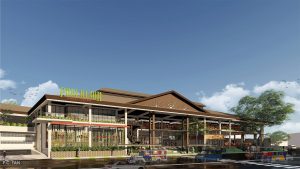
When a series of strong earthquakes shook the southern part of Mindanao including the city, the first industry in the region to feel the impact was property development, particularly the condominium projects.
The industry slump was immediately felt after the city government condemned two condominium projects, the first to be built in the city, as one of the buildings of the Ecoland 4000 collapsed after the last earthquake on October 31.
Japhet Diones, Chamber of Real Estate and Builders’ Association – Davao Chapter vice president, admitted that several prospective buyers who were his clients immediately told him they were having second thoughts in pursuing their plans.
But Diones is confident that the industry will be able to recover “given that based on history, usually two to three years after the events, the market will rebound.”
For industry stakeholders, there is no reason to wait for the industry to recover as the belief was that the impact was negligible and only felt by the company who built the projects that were declared unsafe.
More projects

In the case of the homegrown Damosa Land Inc., the company is completing its six-building condominium project in Sasa as Ricardo F. Lagdameo, company first vice president, said he is confident that the impact of the tremor to the market was minimal.
“We continue to receive inquiries,” said Lagdameo, adding that aside from the project, the company is also preparing to eventually start two other projects in the nearby Panabo City and Island Garden City of Samal in Davao del Norte.
Lagdameo, grandson of the late company founder Don Antonio O. Floirendo, said the Panabo project, an 88-hectare Agriya, will soon introduce its residential company, a high-end subdivision.
Aside from the residential and commercial components, Agriya will also have a theme park as well as a satellite campus of the University of the Philippines- Los Banos to address the need for graduate studies in the region.
The company is also finalizing its 12-hectare Bridgeport project in Island Garden City of Samal which will have both a condominium and high-end subdivision components.
Not to be outdone by its local competitors, the Villar Group has also been heavily investing in the city despite the earthquakes.

The Condominium Homes (COHO) brand of Vista Land and Lifescapes Inc. is building four condominium projects in the city simultaneously.
Last month during the inauguration of the brand’s showroom, Jennifer C. dela Cruz, brand president, said the company decided to start the projects because the areas “have become prime locations.”
Another brand of the Villar Group, the Camella Communities also last month launched its Camella Toril project, a mid-range subdivision that will cater to those who want to buy houses in the southernmost part of the city.
Teresa P. Tumbaga, Camella Communities president, said during the launching of the project that since last year, Mindanao in general has become the top performer in terms of revenues among the three biggest islands.
But property development projects are not limited to residential projects as another homegrown company, Alsons Development and Investment Co. (AlsonsDev), the Alcantara brand for commercial property, is putting up the Poblacion Market Central, a 3,892-square meter retail strip that will try to complement the setting up of condominium projects in the city center.

The project, just a block away from the iconic Aldevinco Shopping Center, will become the “celebration of the city’s evolving identity and promising art, retail, and food scene” and “a place where heritage meets hip,” the company said in its electronic mail to the TIMES.
“With modern high-rise condominiums rising alongside top-tier hotels and universities in the area, the project’s location is indeed a prime commercial address,” it added as the place will host retail brands and local restaurants as the company is hoping that it will also become a go-to place for both locals and visitors.
Economic backbone

These developments are happening even as the industry is just slowly recovering from the impact of the earthquake, although experts like CREBA’s Diones and even Regional Director Maria Belenda Q. Ambi confirmed it is hard to quantify the effect of the tragedy to the industry.
Ambi confirmed that the real property development, at least in the region, is the biggest infuser of capital. Based on the record of the agency, the 12 big-ticket projects that were registered before the Board of Investments (BOI) during the first three quarters of the year, real property accounted for five.
BOI-registered projects were those that sought for the granting of incentives by the national government as Ambi said there were other projects that were registered with the city government and that these were not included in the report.
Ambi hopes that the industry will continue to grow come next year, “as it will slowly free itself from the impact of the earthquakes.”
